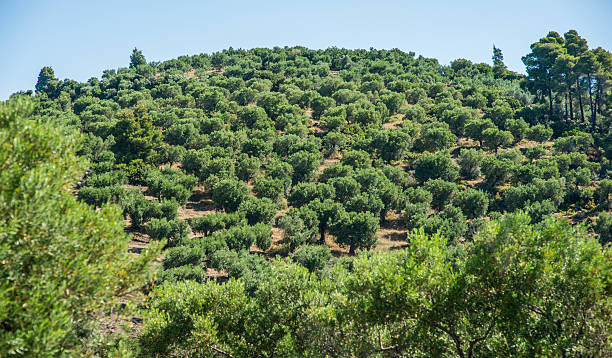4 - Improving Plants
As people start to
understand the biology of plants, one also tries to improve crops according to
the preferred characteristics that one wants to see in the plant, improving
plants from their origin. In this week’s blog we will look in which manner the
olive tree pollinates, transgenic plants in agriculture, Spanish olive trees
breeding program(s) and understand whether olive trees with the same genotype
grown in different regions in Spain have got the same phenotype.
Pollunation
in olive trees
Despite many
varieites requiring cross-pollination, most olives trees are self-pollinating (self-fruitful), meaning that bees or
the wind can pollinate a single tree and then the tree is able to bear fruits (Florida
Concerts, N.D.) .
A research has show that the crop shows features characteristics of species that
belongs to the self-incompatibility group (Olmedilla, 2012) :
Having bicellular
pollen: a single generative cell (University of
Leicester, N.D.)
Wet-papillate stigma
Solid style
Do you support the
use of transgenic plants in agriculture? Why or why not?
Trangenic
plants in agriculture
Trangenic plants are crops
where the DNA have been manipulated in the laboratory with the help of
recombinant DNA methods (Dale, 1993) . This is done by
cutting and rejoining segments of DNA precisely to eachother. There are advantages
linked in the introductions of genes in organisms such as resistance to certain
diseases, pests and herbicides, and increased yield in low fertility soils (Parvaiz
Ahmad, 2012) .
One of the main reasonable reason given by supporters of trangenic plants is related
to world population that one wants to be able to feed. Therefore in order to
feed the 10 billion population in 2050 one expect to do this by improving
plant’s DNA. I am in between the debat, as I understand this given argument,
but at the same time believe that we should not change any plant’s DNA. Hence,
I believe instead of changing crops, we need to adapt ourselves to them.
Olive
tree breeding program(s) in Spain
Due to its long
lifespan, the olive tree is said to be a suitable model to study the origin of
cultivars (Concepción M. Díez,
2011) .
There are currently several breeding programs operating in Spain. Of which the
first olive breeding program was introduced in 1990-91, in Córdoba (The Córdoba Breeding Program, was developed
by the University of Córdoba and the IFAPA), which aimed at superseding the
usage of the main cultivars (Rosa, 2007) (Rallo, N.D.) . Next to this, early
fruit bearing and high oil productivity were the two main objectives for the
introduction of this breeding program.
When breeding olive
trees one makes use of traditional techniques, which involve in crossing amoung
parents of known (Lorenzo Leon, 2014) , and clonal
selection (Andrea Fabbri, N.D.) .
Breeding olive tree has
resulted in productive varieites with high oil content (with traits as eraly fruit bearing and oil composition) (Rallo,
N.D.) ,
resistance to pests and abiotic stresses (frost and drought), and high-quality
production (Andrea Fabbri, N.D.) .
Genotype
A survey that aimed
to look for phenotypic diversity within olive, had concluded that it is an
unusual phenomenon (Concepcion M. Dıez,
2011) .
This might be because of small differences in genetic in the cultivars, since
they belong to ancient known cultivars or simply because the olive tree is able
to adapt itself in different climate.
References
Andrea
Fabbri, M. L.-T. (N.D.). Olive Breeding. Springer Link. Retrieved
September 26, 2017, from
https://link.springer.com/chapter/10.1007/978-0-387-71201-7_12
Concepcion
M. Dıez, I. T. (2011). Centennial olive trees as a reservoir of genetic
diversity. Oxford Journals. doi:10.1093/aob/mcr194
Concepción
M. Díez, I. T. (2011). Centennial olive trees as a reservoir of genetic
diversity. Oxford University Press. doi:10.1093/aob/mcr194
Dale,
P. (1993). The release of transgenic plants into agriculture. Cambridge
University Press. doi:10.1017/S0021859600073524
Florida
Concerts. (N.D.). Olive Tree Pollination and Yields. Retrieved
September 25, 2017, from Florida Concerts:
http://floridaconcerts.org/http-www.floridaconcerts.org-olive-trees-and-pollination.htm
Images,
G. (n.d.). Olive trees. Olive trees in Tuscany, Italy. Retrieved
September 28, 2017, from http://time.com/3856921/italy-olives-plague/
Lorenzo
Leon, L. V. (2014, August 15). Initial selection steps in olive breeding
programs. doi:10.1007/s10681-014-1232-z
Olmedilla,
I. S. (2012). Histochemical location of key enzyme activities involved in
receptivity and self-incompatibility in the olive tree (Olea europaea L.).
ScienceDirect. Elsevier. Retrieved September 25, 2017, from
http://www.sciencedirect.com/science/article/pii/S0168945212001501#bib0140
Parvaiz
Ahmad, M. A.-Q. (2012). Role of transgenic plants in agriculture and
biopharming. Elsevier. doi:10.1016/j.biotechadv.2011.09.006
Rallo,
L. (N.D.). The olive growing in Spain and its genetic. Retrieved September
26, 2017, from FOSAN: http://www.fosan.it/system/files/Anno_42_1_3.pdf
Rosa,
L. L. (2007). Breeding for Early Bearing in Olive. HortScience.
Retrieved September 26, 2017, from
http://hortsci.ashspublications.org/content/42/3/499.full
University
of Leicester. (N.D.). Pollen is... Retrieved September 25, 2017, from
University of Leicester: Pollen is...



Reacties
Een reactie posten